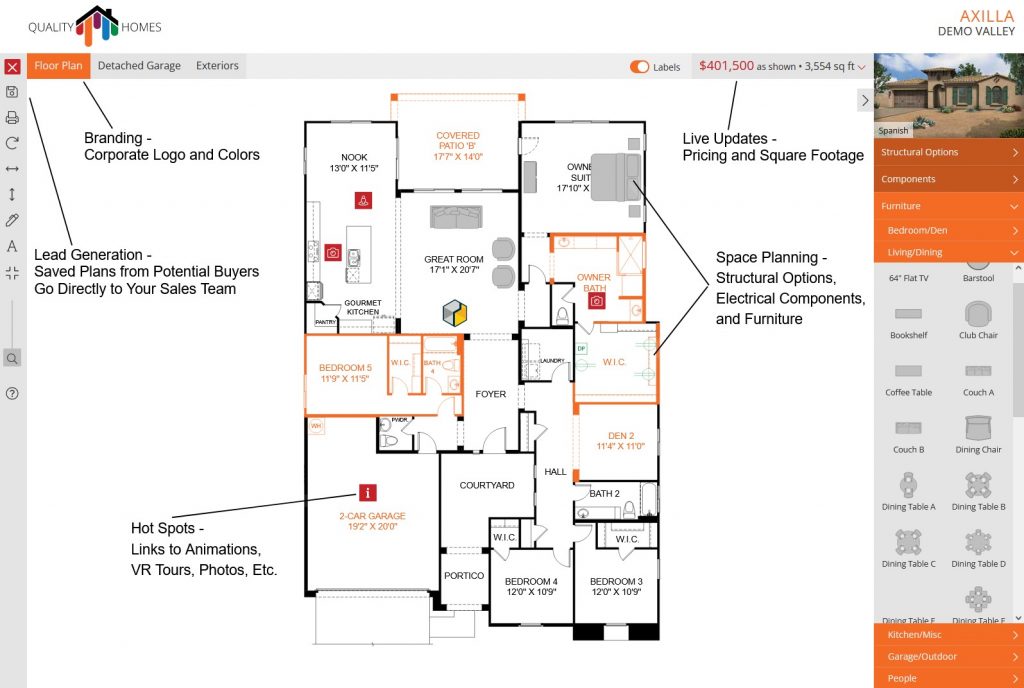
Why Homebuilders Can’t Afford to Overlook This Essential Tool
Every touchpoint with a potential homebuyer matters in today’s competitive homebuilding market. From the first moment they walk into a sales office, the experience they have can shape their entire perception of the builder. Investing in creative, high-quality sales office displays isn’t just about aesthetics. It’s about standing out, making an impact, and driving more sales.
Yet, some builders are moving away from dedicated sales offices, choosing instead to rely solely on digital interactions or remote appointments. While technology has its place, eliminating or minimizing the role of a well-designed sales office can be a costly mistake. Here’s why sales office displays remain a crucial part of the homebuyer journey and why skimping on this aspect can put a builder at a disadvantage.
Creating a Lasting First Impression
The moment a homebuyer steps into a model home sales office, they begin forming an opinion about the builder. Are they professional? Do they pay attention to detail? Can I trust them to build my future home?
High-quality displays, such as vinyl wall wrap graphics, floor plan displays, and wall-mounted site plans, create an immersive, informative, and visually appealing environment that reassures buyers they are in the right place. A thoughtfully designed space instills confidence, whereas a sparse or uninspiring space can leave buyers feeling uncertain or even skeptical about the builder’s credibility.

Standing Out from the Competition
In many markets, homebuilders compete in the same neighborhoods, sometimes even across the street. A compelling sales office design can be the differentiator that helps one builder stand out from the rest.
Imagine two homebuyers visiting back-to-back sales offices. One builder features stunning wall graphics showcasing the lifestyle of the community, engaging video displays with customer testimonials, and an interactive site plan that allows buyers to visualize available lots. The other builder offers only a few brochures and a generic table with a sales rep. Which experience is more memorable? Which builder will leave a stronger impression?
Investing in creative and high-quality displays sends a message that the builder values their product, brand, and, most importantly, customers.
The Psychology Behind Visuals and Tapping into Emotion
Homebuying is an emotional process. I dare you to deny that. Buyers aren’t just choosing a house; they’re envisioning their future. A well-designed sales office fosters positive emotions, making homebuyers feel excited, inspired, and comfortable. Here’s how:
- Trust and Confidence: Professionally designed displays communicate stability and professionalism, making buyers feel they’re working with a reputable builder.
- Excitement and Aspiration: Lifestyle imagery, high-quality renderings, and engaging video content help buyers imagine themselves living in the community.
- Clarity and Understanding: Interactive maps, floor plans, and community overviews eliminate confusion and make it easier for buyers to visualize their options.
Without these elements, a sales office can feel impersonal, transactional, or even forgettable. We want to inspire buyers to take the next step. Creating a memorable environment is worth it if buyers remember you after they walk out the door.

What’s Lost Without a Sales Office?
Builders who eliminate or scale back their sales offices risk losing a key element of the sales process. A well-staffed and well-designed space allows sales teams to:
- Guide buyers through the decision-making process in a controlled, branded environment.
- Build relationships and answer questions in real-time.
- Reduce buyer hesitation by providing visual and tangible reinforcements of the community’s value.
Without a dedicated space, buyers may rely on online research alone, where competing builders have just as much visibility. Worse, buyers may lose interest or become overwhelmed without the personal guidance and reassurance a sales office provides.
Weighing the Quality vs. Cost Investment
Some builders hesitate to invest in high-end sales office displays due to cost concerns. However, opting for cheap or outdated materials or skipping displays altogether can be even more expensive in the long run. Poor presentation can lead to lost sales opportunities, reduced buyer confidence, and a weaker brand reputation.
On the other hand, high-quality, well-designed displays have a lasting impact and require minimal updates compared to the revenue they help generate. A well-thought-out investment in sales office displays pays for itself through increased buyer engagement, higher conversion rates, and stronger brand loyalty.
The Bottom Line: Sales Office Displays Drive Results
For national production homebuilders, the sales office is more than just a place to meet buyers. It’s a critical tool in the sales process. The right displays create an engaging, informative, and emotionally compelling experience that turns interest into action. In a market where first impressions and differentiation matter, builders can’t afford to overlook the power of a well-designed sales office.
Now is the time to invest in displays that showcase your brand, engage buyers, and set your communities apart. After all, a strong first impression leads to a lasting relationship and, ultimately, more home sales.
Want to learn more about Sales Office Displays?













